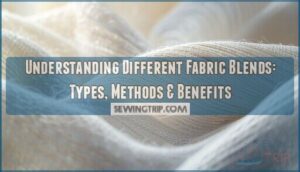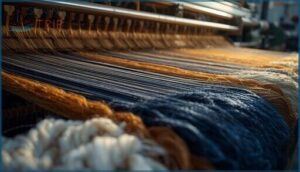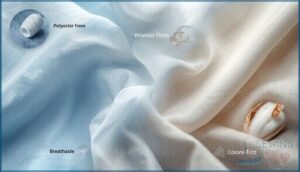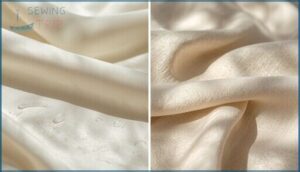This site is supported by our readers. We may earn a commission, at no cost to you, if you purchase through links.
Your favorite shirt doesn’t wrinkle after a full day of wear, your workout leggings stretch without losing shape, and that cozy sweater dries faster than pure wool ever could. These aren’t happy accidents—they’re the result of understanding different fabric blends, where manufacturers strategically combine fibers to create textiles that outperform their single-fiber counterparts.
Cotton brings breathability, polyester adds durability, spandex delivers stretch, and when blended in the right proportions, they solve the limitations each fiber faces alone. The science behind these combinations affects everything from how long your clothes last to how comfortable you feel throughout the day, making blend ratios and fiber pairings more than just technical details on a care label.
Table Of Contents
Key Takeaways
- Blended fabrics combine two or more fiber types in strategic proportions to achieve performance characteristics that single fibers can’t deliver alone, like merging cotton’s breathability with polyester’s durability to create materials that balance comfort, longevity, and cost.
- The blending process happens at different manufacturing stages—from bale mixing through flock processing to sliver blending—with precision controls maintaining blend ratios within ±1-2% tolerance, directly impacting yarn evenness and final fabric quality by 60-70%.
- Popular blends like 65/35 polyester-cotton dominate the market because they solve real problems: polyester adds wrinkle resistance and cuts production costs by 20-40%, while cotton maintains breathability, creating everyday fabrics that outperform pure materials in durability tests and wash cycles.
- Choosing the right blend means matching fiber ratios to your actual needs—higher cotton content prioritizes breathability for hot climates, while synthetic-dominant blends offer easy care and shape retention, with care labels revealing the engineering strategy behind each garment’s performance.
What is Blended Fabric
Blended fabric combines two or more different fiber types to create a material that performs better than any single fiber alone. Manufacturers blend fibers to achieve specific goals, whether that’s adding stretch, improving durability, or balancing cost with comfort.
Let’s break down what blended fabric really means, how the blending process works, and the main types you’ll encounter.
Definition and Purpose
Understanding fabric blends starts with recognizing what they are: textiles combining two or more distinct fiber types in predetermined proportions. You’re looking at engineered materials that achieve properties no single fiber can deliver alone.
The blending rationale revolves around three core goals. First, property optimization merges each fiber’s strengths—like polyester’s resilience with cotton’s softness—creating fiber synergy that enhances performance. Second, cost efficiency balances premium materials with affordable alternatives without sacrificing quality. Third, aesthetic goals reveal unique textures and visual appeal.
A significant challenge, however, lies in recycling blended fabrics due to their complex composition. Defining fabric blends means recognizing this strategic fusion that transforms ordinary textiles into customized solutions for your specific needs.
Fabric Blending Process
Creating blended fabric starts with strategic fiber preparation—your foundation for quality textiles. The fabric blending process unfolds through distinct stages: bale mixing combines fibers from multiple sources, then flock processing opens and cleans material before web formation aligns everything systematically.
The goal is to create custom woolen blends with specific performance characteristics. Next, you’ll achieve sliver uniformity through drawframe consolidation, ensuring consistent roving thickness before final spinning. Each blending process stage builds fiber blending precision into your textile manufacturing workflow.
Types of Fabric Blends
Blended fabrics organize into three core types, each serving distinct purposes. You’ll encounter Natural-Synthetic combinations like 65/35 cotton-polyester that balance breathability with durability. Performance Finishes incorporate moisture-wicking treatments into fabric blend combinations for activewear. Specialty Combinations merge luxury fibers—think silk-wool ratios—for premium applications.
These popular fabric blends vary by fiber combinations and weave structures, giving you targeted solutions for every textile challenge.
Fabric Blending Methods
Blending fibers isn’t a one-size-fits-all process—manufacturers use different methods depending on the fabrics they’re creating and the properties they want to achieve. Each technique has its own timing in the production chain, from raw fiber bales to the final yarn stage.
Let’s look at the main blending methods that turn separate fibers into the durable, comfortable fabrics you wear every day.
Bale Mixing and Flock Blending
You start with bale laydown—usually 6 to 60 bales per batch—to even out fiber properties before blowroom processing.
Modern automation benefits are clear: bale management systems cut variation by 30–40%, while flock blending doses multiple fiber blends at rates exceeding 1,000 kg per hour, holding blend recipes within ±1–2% tolerance.
This precision in fiber blending improves yarn evenness by 10–15%, transforming raw textiles into consistent blended fabric.
Web Blending and Sliver Blending
At the ribbon lap or drawframe, you’ll find web blending doubling 4–8 webs to slash mass variation by 20–30%. Sliver blending at the drawframe combines multiple card slivers, keeping your blend ratios within ±1% across thousands of meters. This precision boosts yarn evenness by 60–70% and delivers excellent blend homogeneity.
- Fiber parallelization improves through drawframe action, reducing fiber entanglement
- Rotor spinning benefits dramatically from additional sliver blending precision
- Blended fabric consistency increases as fiber combinations stabilize early
- Fabric blends maintain uniform shade and handle across production runs
Fiber Blending and Roving Blending
At the card, fiber blending combines cotton and polyester tufts in ratios like 50:50 or 60:40, delivering the best blend homogeneity for yarn production. You’ll notice fiber blends show enhanced evenness with fewer imperfections.
Roving blending happens later at the ring frame, letting you introduce specialty fibers and create heather effects without disrupting earlier stages. While roving blends offer quick style changes, they increase yarn hairiness and reduce spinning stability compared to fiber-blended fabric processed at carding.
Benefits of Fabric Blends
Fabric blends aren’t just a compromise between different fibers—they’re designed to deliver advantages you won’t find in single-fiber materials. When you choose a blended fabric, you’re getting a material engineered to outperform its individual components in specific ways.
Fabric blends aren’t compromises—they’re engineered materials designed to outperform any single fiber alone
Let’s look at the key benefits that make fabric blends the go-to choice for everything from everyday clothing to specialized technical applications.
Improved Performance and Durability
Think of fabric blends as your wardrobe’s secret armor—these fiber combinations deliver mechanical durability that single-fiber fabrics simply can’t match. When you choose blended fabric, you’re investing in performance that shows up in three key ways:
- Tensile strength soars 20-30% higher in polyester-cotton blends compared to pure cotton
- Abrasion resistance protects high-stress areas from daily wear and tear
- Shape retention keeps garments looking fresh through countless washes
That’s durability you can trust.
Enhanced Comfort and Aesthetics
When your fabric touches skin, comfort becomes immediate—and that’s where blended fabric shines. Cotton-bamboo combinations increase moisture-wicking by 30%, keeping you dry in humid conditions. Polyester-cotton blends with higher cotton content (67/33) feel 25% more comfortable than their synthetic-heavy counterparts.
Visual Texture improves dramatically too: wool-silk blends offer 35% greater drape for that luxurious flow, while polyester-cotton mixes retain Color Retention 40% better after twenty washes.
Skin Feel matters—bio-based fiber blends reduce friction by 15%, preventing irritation. That’s why 78% of consumers prefer fabric blends for everyday Aesthetic Appeal and lasting comfort.
Cost Optimization and Versatility
Your budget stretches further when you choose fabric blends strategically. Cotton-polyester combinations slash production cost savings by 20%-40%, while raw material reduction reaches 7%-10% in yarn manufacturing. Economic advantages multiply across applications:
- Polyester-cotton blends cut fabric expenses dramatically
- Wool-polyester ratios improve suit production costs
- Nylon-cotton provides wear-resistant versatility
- Elastane combinations expand technical applications
- Blend ratio impacts determine final pricing
Application versatility transforms how you approach garment selection, making cost reduction and quality compatible goals in today’s textile market.
Popular Fabric Blends
Now that you know how blending improves fabric performance, it’s time to look at which combinations actually work in the real world.
Each blend below has a specific purpose, from everyday T-shirts to high-performance activewear. You’ll see how different fiber pairings solve practical problems while balancing comfort, durability, and cost.
Polyester and Cotton Blends
Polyester-cotton blends dominate the market for good reason—they hold 60% market share by delivering unparalleled versatility. You’ll encounter common blend ratios like 65/35 or 50/50, each optimized for specific performance needs.
The polyester component provides wrinkle resistance and durability that passes rigorous tests, while cotton ensures breathability and comfort factors that keep you cool throughout the day.
Nylon and Spandex Blends
When you slip into gym shorts or compression leggings, you’re experiencing nylon-spandex engineering at work. These fabric blends commonly combine 75-85% nylon with 15-25% spandex, creating activewear that moves with you while holding its shape through intense workouts.
Here’s why this combination dominates performance textiles:
- Superior elasticity factors: Premium blends maintain 95% recovery after 50 wash cycles
- Proven durability testing: 92% elasticity retention survives 100 washes
- Optimized comfort qualities: 85/15 ratios deliver excellent moisture-wicking while providing four-way stretch
These blend ratios transform ordinary sportswear into gear that withstands your toughest training sessions.
Silk and Wool Blends
If your wardrobe demands both elegance and warmth, silk and wool fabric blends deliver precisely that. Typical blend ratios feature 60-80% wool with 20-40% silk, where a 70/30 configuration balances insulation with lustrous sheen. These luxury applications shine in high-end sweaters and formal scarves.
The fabric blend properties include enhanced breathability and enhanced texture, though care considerations require gentle handling to preserve the delicate silk fibers throughout the garment’s lifespan.
Acrylic and Linen Blends
While silk and wool target luxury markets, acrylic-linen blends take a different approach—prioritizing practicality over prestige. You’ll discover these fabric blends combine acrylic’s quick-drying properties with linen’s natural breathability.
Blend Durability comes from acrylic’s 1.17-1.20 g/cm³ density, while Moisture Management benefits from linen’s absorption paired with acrylic’s 1.5-2% moisture regain.
Cost Analysis reveals significant savings over pure linen, making acrylic-linen combinations ideal for summer clothing where Comfort Factors and varied Weave Structures deliver both performance and affordability.
Choosing Fabric Blends
Choosing the right fabric blend isn’t just about picking what feels good—it’s about matching the material to your actual needs. You’ll want to think through how you’ll use the garment, what kind of wear it’ll face, and whether the price fits your budget.
Let’s break down the key factors that’ll help you make smart decisions about fabric blends for your wardrobe.
Selecting Right Fabric for Wardrobe
Building the right wardrobe starts with understanding blend performance and how different fabric blends serve your lifestyle. Match your choices to actual wardrobe needs—cotton-polyester delivers reliable everyday wear, while wool blends offer warmth you can count on.
When choosing fabric blends, consider these practical factors:
- Climate fit – breathable cotton mixes for heat, insulating wool blends for cold
- Activity level – stretch-enhanced fabric blend options for movement
- Care requirements – low-maintenance polyester-cotton versus delicate silk combinations
- Budget considerations and ethical sourcing – value and values working together
Your fabric blend benefits multiply when you align material properties with how you actually live.
Considering Durability and Comfort
Durability determines whether your clothes become favorites or frustrations. When you’re evaluating fabric blends, blend performance matters just as much as how soft something feels in the dressing room. Polyester-cotton blends retain 90% of their tensile strength even after 50 wash cycles—that’s real staying power. You’ll find abrasion resistance varies dramatically too: nylon endures 4500 Martindale cycles before showing wear, while polyester withstands 3500.
Moisture wicking becomes essential if you live in humid climates or stay active. Cotton-polyester combinations dry 45% faster than pure cotton, keeping you comfortable throughout the day. Shape retention separates garments that look fresh from those that sag and stretch. Blends with 65% polyester wrinkle 60% less than 100% cotton shirts.
Balance these fiber combinations against your lifestyle. High-wear performance fabrics suit busy schedules, while comfort-focused blends work for relaxed environments. Your fabric blend benefits multiply when durability matches your actual needs.
Evaluating Aesthetics and Cost
How do you find the sweet spot between good looks and smart spending? Fabric blends excel at price positioning—polyester-cotton combinations deliver aesthetic norms at mid-range costs because synthetic dominance keeps production affordable.
You’ll notice perceived value stays high when blend ratios balance drape and finish with cost optimization and versatility. The aesthetic appeal doesn’t demand premium pricing when you understand fabric blends’ cost-effectiveness advantage.
Identifying Blend Ratio and Care Instructions
How do you decode what’s actually in your fabric? Federal law requires fabric labels to list fiber percentages in descending order—you’ll see compositions like “65% polyester, 35% cotton” that tell the whole story.
Reading ratios helps you predict performance: higher synthetic content means easier care and maintenance, while natural-fiber dominance offers breathability. Care symbols on labels guide washing temperatures and drying methods for each blend.
Verification methods like thermogravimetry confirm accuracy within 2%, protecting you from mislabeling. Companies face compliance penalties up to $16,000 per violation, so trust those percentages when choosing your fabric blends.
Frequently Asked Questions (FAQs)
Why should you blend different types of fabrics?
Think of fabric blending as performance engineering: you’re maximizing durability and comfort while cutting costs.
Enhanced properties emerge when cotton’s breathability merges with polyester’s resilience—creating adaptable applications that outperform pure fibers in real-world conditions.
What is a fabric blend?
A fabric blend merges two or more fiber types—like cotton with polyester—to boost durability, comfort, and performance. You’ll get material properties that single fibers can’t deliver alone.
How do I choose a cotton blended fabric?
Start with intended use—cotton-polyester suits everyday durability and wrinkle resistance, while cotton-spandex adds stretch for activewear.
Check blend ratios: higher cotton content boosts breathability and comfort, balancing care needs with your budget.
What are the different types of blended fabric?
You’ll encounter three main categories: Natural-Synthetic blends like cotton-polyester balance comfort with durability, Performance Finishes add moisture-wicking capabilities, and Specialty Combinations such as silk-wool or linen-rayon deliver targeted benefits for specific applications.
What is a blended fabric & how does it work?
As the old saying goes, “The whole is greater than the sum of its parts.” Blended fabric combines two or more fibers—like cotton and polyester—during production, merging each material’s strengths to boost durability, comfort, and performance affordably.
What is the difference between a pure fabric and a blend?
When you choose 100% cotton or wool, you’re getting a single fiber type throughout.
Blends mix two or more fibers—like cotton with polyester—creating fabrics that balance comfort, durability, and cost more effectively than pure materials alone.
How to identify different types of fabrics?
Ironically, fabric labels don’t always tell the whole story. You’ll identify fiber types through burn tests, visual inspection, tactile assessment, water absorbency checks, and chemical dissolution methods—revealing true fabric properties beneath misleading tags.
Is 70% cotton and 30% polyester good?
Yes, a 70/30 cotton-polyester blend delivers excellent comfort balance with breathability from cotton and durability from polyester.
You’ll enjoy reduced shrinkage, better wrinkle resistance, and cost savings compared to pure cotton fabrics.
Is 65% cotton 35% polyester good?
A 65/35 cotton-polyester blend delivers impressive durability and comfort through strategic fiber ratios. You’ll experience cotton’s breathability paired with polyester’s wrinkle resistance.
Tensile strength reaches 34 kg while maintaining excellent cost analysis value for everyday wear.
What is the best fabric blend?
The best blend depends on your intended use and climate factors. For everyday performance, polyester-cotton delivers durability and comfort.
Personal preference and budget impact guide choices between specialty blends offering targeted benefits.
Conclusion
Think of fabric blends like alloy engineering—combining metals creates steel stronger than iron alone. The same principle applies when understanding different fabric blends: strategic fiber combinations deliver performance no single material can match.
You now recognize how blend ratios, mixing methods, and fiber pairings directly impact your clothing’s durability, comfort, and care requirements. Armed with this knowledge, you can read those care labels differently—seeing not just washing instructions, but the textile science working in your favor.
- https://www.futuremarketinsights.com/reports/blended-fibers-market
- https://dataintelo.com/report/global-cotton-blended-fabric-market
- https://www.datainsightsmarket.com/reports/cotton-blended-fabric-1073253
- https://textileexchange.org/app/uploads/2024/09/Materials-Market-Report-2024.pdf
- https://textile-yarn.com/blog/whats-the-difference-between-cotton-and-polyester/














